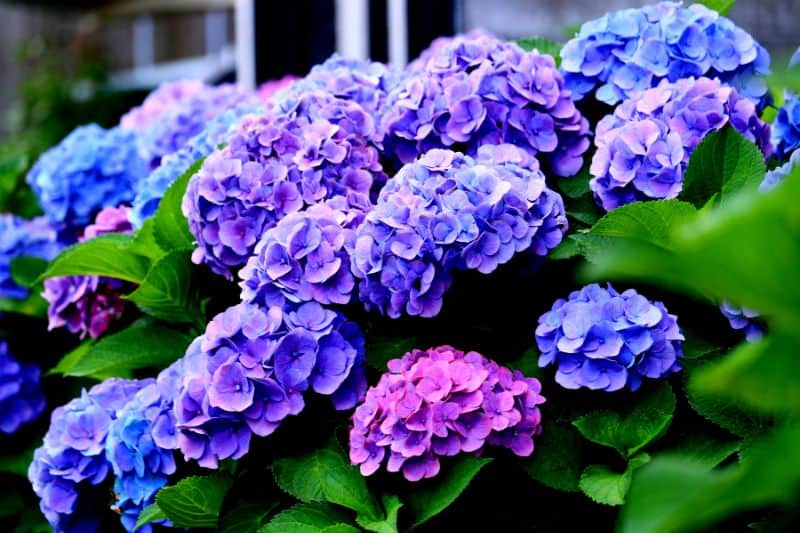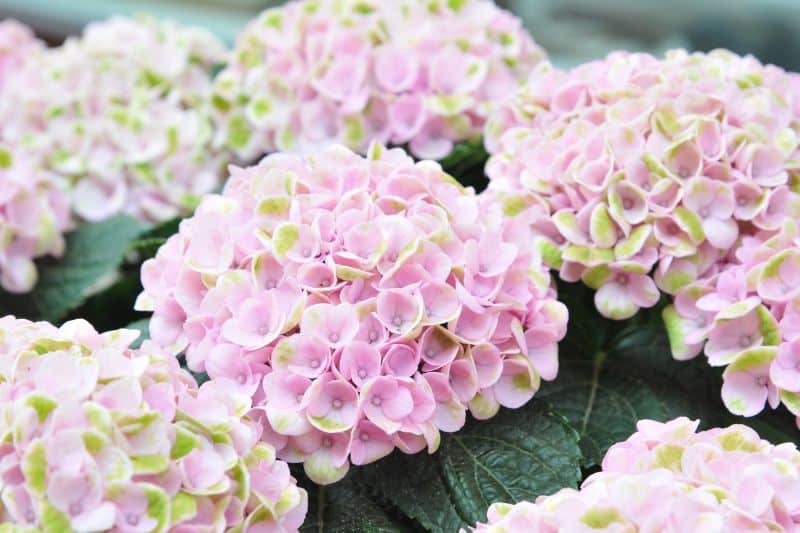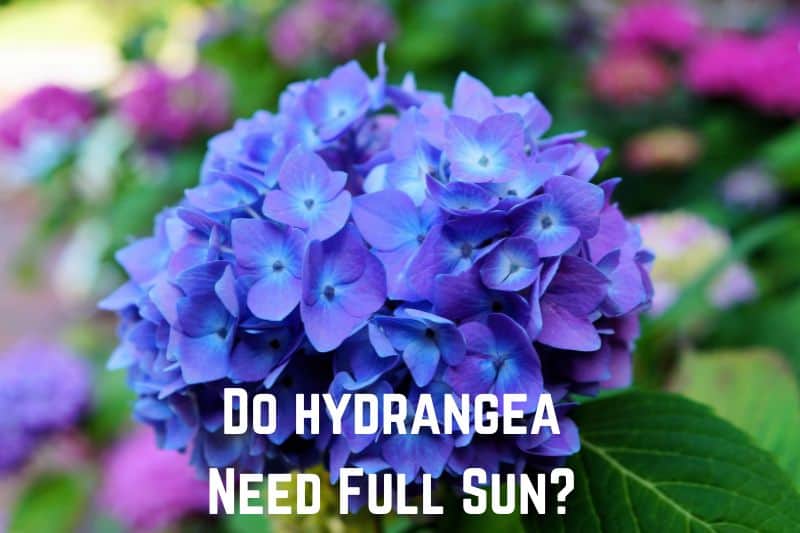Hydrangeas are a fantastic choice for home landscaping because they offer a range of benefits that can enhance your outdoor space’s overall look and feel. First, they come in various vibrant colors, from soft pastels to bold blues, which can add a pop of color and visual interest to any garden or yard.
Hydrangeas are known for their large, showy blooms, which can create a beautiful focal point in your landscape design. Another great thing about hydrangeas is that they are relatively low-maintenance plants. They are hardy and can tolerate different soil types and weather conditions, making them an ideal choice for beginner and experienced gardeners.
Do hydrangeas need full sun? Well, this is one of the things that most people want to know. So, we dig in deep and understand the sunlight requirements for hydrangea.
Read: Does Lemongrass Need Full Sun? (Answered)
Do Hydrangea Need Full Sun or Shade?
When it comes to sun exposure, they’re versatile. While hydrangeas enjoy some sun, they don’t necessarily need full sun all day. Too much direct sunlight can scorch their delicate leaves. Ideally, hydrangeas prefer a balance of sun and shade throughout the day.
Hydrangeas are versatile flowering plants that can grow in a variety of environments. When it comes to sunlight exposure, they can thrive in both sun and shade. However, the specific sunlight requirements may vary depending on your hydrangea type.
First, hydrangeas come in different varieties, each with specific care requirements, so choosing the right one for your climate and gardening conditions is essential. Next, hydrangeas prefer well-draining soil and thrive in partial shade, so pick the right spot in your garden.
Bigleaf and Oakleaf hydrangeas prefer partial shade, especially in the afternoon when the sun is the strongest. It’s important to provide them with about four hours of dappled sunlight per day. You can plant them under trees or on the east side of your home to ensure they receive morning sun and afternoon shade.
Panicle and Smooth hydrangeas, on the other hand, can tolerate more sun exposure. They thrive in full sun to partial shade, requiring at least six hours of sunlight per day. These types can be planted in more open spaces or on the south and west sides of your home to ensure they receive adequate sunlight.
To determine the right location for your hydrangea, consider the specific sunlight requirements of your chosen variety. Remember that too much sun can scorch the leaves and cause the flowers to fade, while too little sun may result in fewer blooms or leggy growth.
Maintaining proper moisture levels is also essential, as hydrangeas are not very drought-tolerant. A layer of mulch around the base of the plant can help retain moisture and keep the roots cool, especially in sunnier locations. Regular watering is crucial, particularly during dry spells or hot summer days.
How Much Sunlight Does Hydrangea Need?
Hydrangeas are like sun worshippers; they thrive on sunlight! These beautiful flowering plants need at least 4-6 hours of sunlight daily to grow and bloom their best. So, if you’re thinking of adding a hydrangea to your garden, find a sunny spot to soak up those rays. Of course, as with any plant, too much of a good thing can be harmful.
While hydrangeas do need sun, it’s recommended not to have more than 6 hours of direct sunlight; it might start to wilt, or its leaves could get scorched. So finding that sweet spot of just the right amount of the sun is key to keeping your hydrangea happy and healthy.
And remember, if you live in a hot climate, providing shade during the hottest part of the day can help protect your hydrangea from getting too much sunburn.
Hydrangeas are beautiful plants that thrive in various light conditions, but when it comes to shade, they prefer some protection from the hot afternoon sun.
Can Hydrangea Get Too Much Sun?
Hydrangeas are a beautiful addition to any yard, but can they handle too much sun? Well, here’s the deal. While hydrangeas love a good dose of sunlight, too much direct sunlight can cause problems for these lovely plants.
Hydrangeas can experience leaf scorching, wilting, and overall stress when exposed to excessive sun, leading to stunted growth and even damage to the flowers.
Hydrangeas do need sun. However, they also need shade, So it’s important to find a balance and provide some shade or protection during the hottest parts of the day.
While hydrangeas can be sensitive to direct sunlight, they are resilient plants and can bounce back with a little TLC. To nurse your hydrangea back to health after sun damage, provide shade or move it to a spot with filtered sunlight.
Ensure to water it regularly, keeping the soil moist but not waterlogged. You can also mist the leaves to provide some extra hydration. Pruning any dead or damaged plant parts will help stimulate new growth. With proper care and attention, your hydrangea has a good chance of thriving again in no time!

Can Hydrangea Grow in Shade?
When it comes to growing in the shade, hydrangeas are adaptable. While they do prefer partial sunlight, they can tolerate shade reasonably well. Some varieties of hydrangeas thrive in shady conditions. The key is to choose the right type for your specific shade conditions.
You have a few options for providing shade for your hydrangeas. First, you can use natural shade by planting your hydrangeas near trees or tall shrubs that will protect them from direct sunlight, and this is especially helpful if you live in a hot climate where the sun can be intense.
Another option is to use artificial shade, such as a canopy or umbrella, to create a shaded area specifically for your hydrangeas. Make sure that whatever shade you choose allows for proper air circulation and doesn’t block too much sunlight.
Hydrangeas with larger flowers require more sunlight, so opt for varieties with smaller blooms if you have a shady spot in mind. Additionally, ensure they have ample water and well-drained soil to keep them happy and healthy. Your hydrangea will flourish even in the shade with a bit of love and attention!
Different Types of Hydrangeas and Their Sunlight Requirements
When selecting the perfect hydrangea for your garden, it’s essential to consider their sunlight needs. Each type of hydrangea has its own sunlight requirements, allowing you to choose the best one for your specific garden conditions.
Bigleaf Hydrangeas (Hydrangea macrophylla) are the most common type and come in mophead and lacecap. They thrive in dappled shade or morning sun with afternoon shade. Ideally, they require at least four hours of sunlight per day. Ensure that they receive consistent moisture, as too much sun can scorch their leaves and cause wilting.
Panicle Hydrangeas (Hydrangea paniculata) are more sun-tolerant than other varieties. They can handle full sun or partial shade but bloom best with at least six hours of direct sunlight daily. However, keeping the soil well-watered is crucial, as panicle hydrangeas are prone to drying out in intense sun.
Smooth Hydrangeas (Hydrangea arborescens), such as the popular ‘Annabelle’ variety, enjoy partial shade. Aim for around four to six hours of sunlight each day. Morning sun with afternoon shade is ideal for beautiful blooms and healthy foliage.
Oakleaf Hydrangeas (Hydrangea quercifolia) are known for their distinctive, oak-shaped leaves. They prefer dappled or partial shade, requiring around four hours of sunlight. However, oakleaf hydrangeas can tolerate more sun if their roots stay cool and provided with a consistent water supply.
Climbing Hydrangeas (Hydrangea anomala subsp. petiolaris) require partial shade for peak performance. While they can tolerate full shade, their blooms may be sparse. Around four hours of sunlight per day should suffice to encourage flower production.
Remember to pay attention to the specific sunlight needs of the hydrangea variety you choose. By selecting the right type based on their sunlight requirements and your garden’s light conditions, you can enjoy their fantastic blooms for years.
Factors Affecting Sun Exposure
Hydrangea Varieties
There are several hydrangea varieties, each with different sun exposure requirements. Some species, like Hydrangea macrophylla (bigleaf hydrangea), prefer partial shade.
On the other hand, Hydrangea paniculata (panicle hydrangea) and Hydrangea arborescens (smooth hydrangea) can tolerate full sun. Knowing your specific hydrangea type is essential to determine the ideal sun exposure for healthy growth.
Climate
The climate in your area plays a crucial role in determining sun exposure for hydrangeas. In cooler climates, hydrangeas can handle more sunlight, while in warmer regions, they usually require more shade, particularly during peak heat hours.
It would be best to observe how the sun shifts in your garden throughout the day and find a spot where your hydrangea gets dappled sunlight or morning sun and afternoon shade, which is often ideal.
Soil Conditions
Soil conditions also affect the amount of sun exposure hydrangeas need. Hydrangeas thrive in well-draining, slightly acidic soil with consistent moisture levels. If your soil tends to dry out quickly, your hydrangea may require more shade to maintain proper hydration.
Conversely, if your soil holds moisture well, your hydrangea can handle more sunlight without stress. To ensure optimal soil conditions, you can amend your soil with organic matter and mulch to help retain moisture and maintain a cool root environment.

Impact of Full Sun on Hydrangea
Flower Health
Regarding hydrangea flower health, full sun exposure can have positive and negative consequences.
On the one hand, sufficient sunlight promotes better flowering, allowing the plant to produce enough energy for optimal growth. However, too much direct sunlight, especially in hotter climates, can cause the delicate blossoms to wither and fade.
To protect your hydrangea flowers from sun damage, you can:
- Place the plant in an area with partial shade, where it receives sunlight for part of the day.
- Water the plant regularly to ensure the soil stays moist, as adequate hydration helps the flowers tolerate some sun exposure.
- Apply mulch around the base of the plant, aiding in moisture retention and temperature moderation.
- Utilize shade cloth or plant taller plants nearby to provide dappled shade during peak sun hours.
Plant Growth
The impact of full sun on hydrangea plant growth varies depending on the specific variety. Macrophylla and quercifolia varieties typically prefer partial shade, while paniculata and arborescens types can tolerate more sun exposure.
Regardless of the variety, monitoring your hydrangea’s growth and adjusting its exposure to sunlight as needed is essential. The signs of too much sunlight include:
- Wilting leaves, particularly during hot afternoons.
- Scorch marks on the leaves, which appear as brown or yellow patches.
- Stunted growth, as excessive sunlight, can stress the plant and impact its overall development.
By balancing sunlight exposure with proper care, your hydrangea will thrive and produce abundant beautiful blooms.
Adjustments for Full Sun
Use of Shades
To protect your hydrangeas from the harsh full sun, it’s a good idea to provide some shade. You can use shade cloths or install a pergola to create a comfortable environment for your plants. Remember that hydrangeas prefer dappled sunlight, so allowing light to filter through the shades will help them thrive.
Proper Watering Regime
Hydrangeas in full sun need consistent and proper watering to prevent them from wilting or drying out. Ensure you water them deeply, at least 1 inch per week, to ensure the soil remains consistently moist.
Remember to water your hydrangeas in the early morning or late afternoon to reduce evaporation, and always water at the base of the plant to keep the foliage dry and healthy.
Pruning Techniques
Managing your hydrangeas’ growth is crucial when exposed to full sun. Proper pruning techniques can help your plants adapt to their sunny environment. Regularly remove dead, damaged, or weak branches to improve air circulation and light penetration.
Also, consider thinning out some older stems to keep the shrub from becoming too dense. Remember to prune your hydrangeas at the right time, typically in late winter or early spring, depending on the variety you have. This will help you maintain its health and encourage beautiful blooms.
Read: Do Gardenias Need Full Sun? (Answered)
How to Grow & Care for Hydrangeas?
Choosing the Right Location
To grow hydrangeas successfully, you must find a spot in your garden that receives partial sun and shade. Most hydrangea varieties can tolerate full sun, but they prefer some shade during hotter parts of the day. Ensure that the area has well-draining soil to prevent root rot.
Planting Hydrangeas
Start by digging a hole that is twice as wide and deep as the container your hydrangea is in. Remove the plant from its pot and gently loosen its roots.
Place the hydrangea in the hole, ensuring the top of its root ball is level with the surrounding soil. Fill in the hole and gently firm the soil around the plant to eliminate air pockets.
Watering Your Hydrangeas
Hydrangeas need consistent moisture to thrive. It’s important to water them regularly, especially during dry periods. Aim for about 1 inch of water per week from rainfall or supplemental watering. Be careful not to overwater, as this can lead to root rot.
Feeding Your Hydrangeas
Hydrangeas will benefit from a balanced, slow-release fertilizer applied in spring and mid-summer. Follow the manufacturer’s instructions on how much to apply and how often. A layer of organic mulch, like compost, can also help provide nutrients and retain moisture in the soil.
Pruning Hydrangeas
Regular pruning can help keep your hydrangeas healthy and looking their best. Some varieties of hydrangeas bloom on old wood, while others bloom on new growth. Determine which type you have before pruning.
You should prune old wood-blooming hydrangeas in late summer or early fall, after the flowers have faded. For new growth-blooming varieties, prune in late winter or early spring.
Following these steps, you’ll be on your way to growing beautiful, healthy hydrangeas in your garden. Remember to monitor your plants regularly and adjust your care routine to maintain their health and vigor.
Frequently Asked Questions
Are there varieties suitable for full sun?
Yes, there are hydrangea varieties that can tolerate full sun. The Panicle hydrangea (Hydrangea paniculata) and Smooth hydrangea (Hydrangea arborescens) are two types that can handle more sunlight compared to other varieties. However, they still prefer some partial shade during the hottest part of the day.
Can hydrangeas tolerate the afternoon sun?
Hydrangeas generally thrive in the morning sun and afternoon shade. While some varieties can tolerate more sun exposure, it is important to provide adequate moisture to help them withstand the afternoon heat. A well-draining soil with a layer of mulch can help retain moisture and protect their roots from excessive temperature fluctuations.
Do hydrangeas need consistent watering?
Yes, hydrangeas need consistent watering, especially during their first few years. The key is to keep the soil consistently moist but not waterlogged. Depending on your climate and weather conditions, you may need to water your hydrangeas once or twice a week. You should monitor their water needs during hot summer days and adjust your watering schedule accordingly.
Are there sun-loving dwarf hydrangea varieties?
There are a few dwarf hydrangea varieties that can handle more sun than their bigger counterparts. For instance, ‘Bobo’, a compact Panicle hydrangea, can tolerate more sun exposure while maintaining its gorgeous blooms. Make sure these sun-loving dwarf varieties receive sufficient moisture, and they will flourish in sunnier spots.






